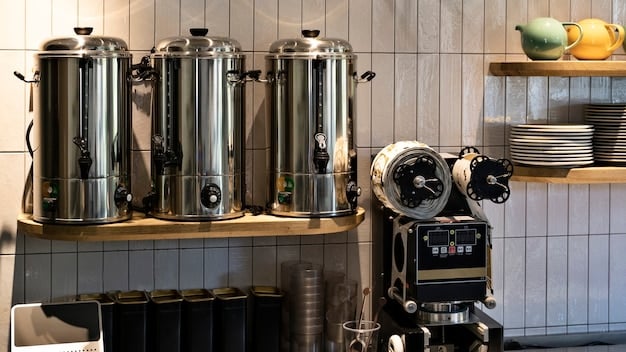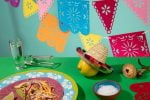Opening a coffee shop in 2025 isn’t just about making great coffee. It’s about having the right equipment to serve a large selection of beverages efficiently.
The coffee shop equipment market is worth millions, and most coffee shops rely on high-quality commercial equipment to maintain consistency and profitability. Yet, many coffee shop owners make critical mistakes when choosing their supplies. Some overspend on super-automatic machines they don’t need, while others cut costs by purchasing new or used equipment that doesn’t last.
In this guide, we’ll look at essential coffee shop equipment that generates profit, not just looks good on your counter. From espresso tampers and steam wands to coffee makers and ice machines for cold drinks, you’ll learn which tools are worth the investment. We’ll also discuss the importance of coffee filters, frothing pitchers, and espresso tampers in crafting the perfect cup of coffee and espresso drinks.
Many coffee shops also find success by sourcing their own coffee beans or partnering with coffee roasters to ensure quality. Additionally, serving breakfast sandwiches and other food items can help increase foot traffic and sales.
We’ll show you exactly what you need to start strong and stay profitable. Because in the coffee business, your equipment isn’t just a collection of machines—it’s the backbone of your success. Whether you’re drafting a business plan or selecting the best commercial equipment, making informed choices will set your coffee shop up for long-term success.
Boost customer satisfaction with just a few clicks
Most-Loved Features:
- On-demand drivers
- Real-time GPS tracking
- Delivery confirmation photos
- Over 50% of customers report a smoother delivery experience
The Must-Have Machines for Opening a Coffee Shop
Getting a coffee shop started requires certain machines. Espresso machines and coffee grinders are at the top of the list.
Best Espresso Machines for Cafes
When picking an espresso machine, several considerations are important.
Durability: You want a machine that lasts over time.
Ease of use: Easy operation keeps the line moving.
Size and capacity: The machine should handle peak times.
Investing in a quality espresso machine comes with benefits. A reliable machine ensures consistent coffee quality, pleasing your customers regularly. Determining which model fits your budget helps ensure a wise purchase. Different price ranges offer varied options without sacrificing quality.
Lifespan of Espresso Machines: Fully automatic and super automatic espresso machines typically last between 5 to 10 years.
Commercial Coffee Grinders
A good grinder plays a vital role in ensuring the coffee tastes great. Consistent grinding leads to better flavor extraction. Here are key features to look for:
Adjustability: Allows tailored grind size for different coffee preparations.
Speed: Faster grinders fulfill customer orders swiftly.
Durability: Built to withstand heavy use.
Brands and models vary in the market. Choosing top brands often guarantees quality and reliability.
Lifespan of Burr Grinders: The lifespan of coffee grinders is 5 to 15 years, processing up to 1,500 pounds of coffee before the blades dull. On average, they last around 7-8 years.
Equipment Judging Criteria
To evaluate equipment, we have formulated the following criteria:
Durability
Ease of Use
Capacity
Cost Effectiveness
Performance
Maintenance Requirements
Brand Reputation
Customer Support
Energy Efficiency
These criteria guide the evaluation and help you allocate your budget where it matters most.

Essential Tools for Coffee Brewing
Find out must-have brewing tools.
Tips for choosing the right tools.
See popular brewing gadgets and how they work.
Essential Coffee Brewing Tools
Brewing coffee is more than just espresso machines. A successful coffee shop needs a selection of brewing tools. These tools cater to diverse coffee preferences and ensure consistency in flavor. Key equipment includes the tamper, which compresses ground espresso beans evenly in the portafilter basket. This ensures even extraction and prevents water from seeping through too quickly. Scales are another must. They help in measuring the exact amount of coffee, ensuring consistency in every cup. It’s like cooking. You wouldn’t just guess how much flour you need.
Milk frothers are essential for making delightful lattes and cappuccinos. Offering drinks like these boosts customer satisfaction. People love options beyond plain coffee, so having several brewing methods avoids boredom. The Chemex, a popular tool, is perfect for making large quantities of drip coffee. It’s not just practical—it’s a conversation starter.
When choosing equipment, think about the coffee you offer. The right tools can bring out the unique flavors of different beans. Investing in quality equipment is crucial. Nobody wants to replace gear every year. Popular choices include the Breville Grind Control, known for its built-in burr grinder and customizable settings, and the Cuisinart DGB-850, famous for its programmable features and adjustable grind size. This equipment ensures consistency and quality with every brew.
Supporting Equipment You Can’t Overlook
Beyond the brewing tools, other equipment ensures a top-notch coffee experience. Water filters play a significant role in this. Good water quality leads to better-tasting coffee. You might have the best beans and methods, but poor water can ruin it. Invest in high-quality filters to ensure clean, pure coffee every time.
Milk frothers are vital for cafes offering milk-based beverages. With them, you can create aromatic and creamy coffee. They transform regular coffee into something special. Next, consider knock boxes. They may seem minor, but they’re essential for hygiene. By collecting used coffee grounds, they keep counters clean and organized. An often overlooked aspect of running a successful coffee shop is the design and layout of the space itself. Strategic coffee shop design can significantly influence customer flow, comfort, and overall satisfaction. Thoughtful layouts ensure baristas work efficiently and customers enjoy their experience, encouraging repeat visits. For insightful ideas on optimizing your space, explore this comprehensive guide to smart coffee shop design.
A well-designed coffee shop not only enhances the customer experience but also improves operational efficiency. Factors such as seating arrangements, lighting, and decor contribute to a welcoming atmosphere that encourages customers to stay longer and return frequently. Furthermore, a smart layout minimizes congestion behind the counter, allowing staff to serve customers quickly without unnecessary movement. For those looking to create an inviting and profitable environment, this insightful post on innovative coffee shop layout strategies offers practical tips that can help maximize your space and attract more foot traffic.
Finally, think about where to get these tools. Look for suppliers with a good reputation. Stores like those online provide user reviews, making it easier to pick the right gear. Be mindful of your budget but prioritize quality. Investing in good equipment now saves money in the long run.
Reflecting on costs, the budget will vary.
General Cost Range: The average cost to open a coffee shop typically ranges from $80,000 to $300,000 depending on various factors such as the type of coffee shop (e.g., sit-down vs. kiosk) and location. For a coffee stand or kiosk, initial costs can be lower, around $60,000 to $105,000.
However, this depends on your location and the quality of the equipment you choose. Equipment choices beyond basic brewing tools can be overwhelming. If you want in-depth reviews, “The Coffee Equipment Guide” by Andrew J. Jeffords offers detailed insights. Online forums like Reddit and coffee-specific subreddits also present user experiences and recommendations.
The debate continues between manual and automatic equipment. Manual tools like pour-over sets offer full control but require skill. Automated gadgets save time, ensuring consistent quality. Coffee experts argue about the balance between control and convenience. Explore the variety of online resources to see what suits your needs best.
Developing a Comprehensive Coffee Shop Menu
A diverse menu boosts sales and customer satisfaction.
Seasonally adjusted items keep customers coming back.
Data-driven menu design increases profit.
Coffee Shop Menu Development Tools
Efficient menu design depends on using the right tools. Tools like MustHaveMenus and Toast enable you to craft visually appealing menus that resonate with your brand. MustHaveMenus provides customizable templates, whereas Toast offers guidance on pricing and data usage.
MustHaveMenus: It allows for versatile menu layout creation. These layouts cater to brand aesthetics and the functional arrangement of menu items. It also offers professional printing services.
Toast: This platform offers insights on effective menu structuring and pricing. Leveraging data can optimize pricing strategies, ensuring you focus on the most profitable items.
Successful coffee shops often use these tools for consistency in design and profitability. For example, a trendy café in Seattle credited Toast’s analytics for identifying less popular items. Removing these helped streamline their offerings and maximize sales.
Popular and Profitable Menu Items Such as Coffee Beans
What sells best? Well, the key is variety. Coffee drinks with add-ons like flavored syrups are consistently profitable. Offering a mix of drinks, such as macchiatos and chai lattes, enhances your menu’s appeal. Don’t forget non-coffee items. Hot chocolate and smoothies offer high margins, often 50-70%, broadening your customer base.
During peak seasons or times of day, demand can shift. Morning rushes may call for quick grab-and-go items, while afternoons might see a spike in requests for leisurely sips like smoothies or teapots. Build menus that adapt.
Additionally, baked goods and sandwiches are popular. These complement coffee sales, especially during lunch hours. A cafe owner, whose shop is across from an office park, noted a 30% boost in sales by focusing on lunchtime offerings like these.
Menu Design Strategies from Top Coffee Shops
Implement tried-and-tested strategies from leading coffee shops to make the most of your menu. Seasonal items create excitement and bring back repeat customers. Update your menu quarterly, integrating popular trends and seasonal favorites. This strategy can refresh the brand identity and attract different customer groups.
Data-driven decisions craft an optimal menu. Utilizing sales data aids in spotlighting best-sellers and weeding out poor performers. This data-driven approach ensures maximizing revenue.
Successful cafes often design menus reflecting their unique brand identity. Consider aesthetics and language consistent with your shop’s vibe.
The Most Profitable Coffee Shop Items
Now, addressing the big question: What is the most profitable item in a coffee shop? It’s typically the flavored drinks. Café au lait, macchiatos, and lattes provide significant markup potential over plain espresso. Additionally, food items like croissants and sandwiches offer complementary sales boosts.
Consider using flavored syrups. They allow a premium price tag on drinks like iced teas and bubble teas. Hot chocolate, though simple, carries a high-profit margin, proving to be invaluable during cooler months.
Inventory Essentials for a Coffee Shop
Essential items needed every day: beans, syrups, cups.
Know how much stock you need for smooth operations.
Find suppliers and manage inventory smartly.
Essential Stock for Daily Operations
Every coffee shop needs a core set of items to keep things running smoothly.
Coffee Beans: Arguably the most important item. Depending on your menu, you’ll need a selection of regular, espresso, and perhaps some specialty beans.
Syrups and Sweeteners: Essential for popular flavored drinks. Consider stocking both mainstream and sugar-free options to cater to all preferences.
Cups and Lids: These are non-negotiable. Stock various sizes to accommodate different drink orders, including hot and cold varieties.
Determining how much inventory is enough comes down to striking a balance between supply and demand. Excess can lead to waste, especially with perishable items like milk. Aiming for a consistent turnover of stock helps keep everything fresh. Consumers increasingly prioritize fresh and high-quality products, with one study noting that “Inventory is like dairy products. No one wants to buy spoiled milk.” This makes the First In, First Out (FIFO) method, which prioritizes older items for use, especially effective.
The complexity of coffee shop operations does not end with inventory, and books like The Coffee Shop Startup Guide can offer expansive insights into the intricacies of managing a coffee shop. It helps both seasoned café owners and newcomers grasp inventory strategies.
Choosing Reliable Suppliers
Finding the right suppliers can make or break your business. Reliable suppliers are crucial for maintaining stock consistency and quality.
Selection Criteria: Price, reliability, product range, and delivery times are key factors to consider. Also, weigh the importance of sustainable and ethical sourcing.
Local vs. National Suppliers: Local suppliers may offer fresher products and faster delivery. However, national suppliers can offer better consistency and bulk discounts.
Building strong supplier relationships can lead to long-term benefits, like negotiating better deals and receiving priority service during shortages. There are upsides and downsides to working with both local and national suppliers. Local suppliers might be more responsive and willing to collaborate on special requests or last-minute needs. National suppliers typically offer more competitive pricing.
For entrepreneurs keen to explore this facet further, Supply Chain Management for Coffee Shops critiques various supplier models and delves into the nuances of different setups.
Future Trends in Coffee Shop Inventory
General Coffee Market Growth:
The global coffee market is projected to grow at a compound annual growth rate (CAGR) of 4.7% from 2022 to 2028, reaching an estimated market value of $51.33 billion by 2028.
With this growth anticipation rate, it’s vital to pay attention to upcoming trends. Sustainability is big. Customers want to know where their coffee comes from, pushing the need for traceable and ethical sourcing.
Stay aware of these market dynamics. Consider integrating tech solutions to manage stock levels. Automated inventory systems can provide real-time updates, minimizing human error and ensuring smoother operations. This technological embrace helps align a coffee shop with broader market shifts towards efficiency and precision.
For more context, industry podcasts such as Coffee Trends and Innovations dissect emerging trends and discuss how technology is reshaping inventory management.
The Role of Technology in Coffee Shops
Modern POS Systems
In today’s fast-paced coffee shop environment, technology plays a vital role. Modern point-of-sale (POS) systems are essential for smooth operations. These systems help streamline transactions and manage orders efficiently. A good POS system offers features like inventory tracking, sales reporting, and seamless payment processing. Popular choices for successful cafes include Square, Clover, and Toast. Each of these systems offers unique advantages, which can make order management much simpler.
Comparison of Popular POS Systems
POS System | Key Features | Customer Ratings | Best For |
|---|---|---|---|
Square | User-friendly interface, mobile compatibility, payment processing, inventory management | 4.5/5 (Capterra) | Small to medium-sized businesses |
Clover | Customizable menus, extensive integrations, customer management tools | 4.2/5 (Business.com) | Restaurants and retail |
Toast | Tableside ordering, robust reporting, online ordering integration | 4.5/5 (G2) | Full-service restaurants |
Digital Marketing Tools for Coffee Shops
Digital marketing is crucial for coffee shops aiming to engage effectively with local communities and grow their customer base. Basic tools such as social media platforms, email marketing solutions, and Google Ads are now standard practices. They help shop owners reach out, interact, and keep their audience engaged. The use of digital promotions can significantly boost sales by targeting specific customer groups. Engaging strategies like vibrant visuals and direct customer feedback can enhance the local brand experience. As Mariam French noted, “The digital ordering should look and feel vibrant, so that sunshine is coming across.”
To ensure a comprehensive understanding of technology in coffee shops, we will examine these criteria in detail:
Functionality of POS systems
Efficiency in transaction handling
Ease of use and installation
Integration with existing systems
Impact on customer experience
Cost-effectiveness over time
This overview will guide you through making informed decisions about technology investments, helping you determine where to allocate resources effectively for optimal outcomes. Choosing the right point-of-sale system can greatly simplify your daily operations and enhance customer experience. For an in-depth review of leading options in the market, check out our detailed guide on the top coffee shop POS solutions. This resource evaluates features, pricing, and integration capabilities to help you select the best system tailored to your coffee shop’s unique needs.
Selecting the ideal coffee shop POS is essential for efficient order management and customer satisfaction. Modern POS systems can integrate with inventory management, loyalty programs, and online ordering, providing a seamless experience. For a comprehensive comparison and expert recommendations, consider visiting this detailed post about top coffee shop POS options to find the perfect fit for your business needs.
Understanding Coffee Shop Industry Terms
Grasp industry terms for seamless coffee shop operations.
Unlock customer satisfaction through clear terminology.
Maintain equipment better with simplified jargon.
Key Coffee Terminology
Every coffee shop owner must grasp essential terms in the coffee industry. This language is not just part of the culture; it informs staff training and enhances customer interactions. Terms like “cappuccino,” “latte,” and “breve” denote specific beverage preparations. Misunderstanding these can lead to customer dissatisfaction. Nuanced differences, such as between ristretto and espresso, are crucial. Ristretto is a shorter, more concentrated shot of coffee compared to the fuller-bodied espresso. Mastering these distinctions can vastly improve the quality of customer service, enhancing the overall experience.
An advanced understanding of terminology is crucial. Texts such as The World Atlas of Coffee by James Hoffmann dive into these distinctions with depth, offering a road map for enthusiasts. Additionally, expert discussions in forums like Barista Hustle provide rich context. The argument for knowing these terms is clear: well-informed staff able to articulate these differences improves customer trust.
For those eager to explore further, joining associations like the Specialty Coffee Association grants access to resources that deepen these insights. Workshops and certification courses offer structured learning paths, ensuring a robust understanding of coffee parlance.
Equipment Jargon Decoded
Understanding equipment terminology is crucial for efficient operation and maintenance. Jargon like “PID controllers,” “portafilters,” and “tampers” are common. A PID controller is vital in regulating the water temperature in espresso machines, ensuring consistency. Portafilters hold the coffee grounds during extraction, while tampers compress these grounds for even brewing.
Simplifying these technical terms aids maintenance and communication among staff. A well-informed team can quickly identify issues, minimizing downtime. Comprehensive guides, like the Espresso Machine Technician’s Handbook, are recommended for those looking to understand the mechanical side of coffee equipment. It explains the intricacies behind the machinery, providing a practical reference for troubleshooting.
Clear communication about equipment function and terminology also fosters a collaborative work environment. Baristas and technicians who speak the same language can efficiently solve problems. This is vital for service continuity and quality assurance.
Menu Lingo and Language
A coffee shop’s menu is a reflection of its brand. Understanding the menu language shapes customer perception. Terms like “house blend,” “single origin,” and “pour-over” need clarity. A “house blend” typically suggests a signature mix unique to the shop, while “single origin” indicates the beans come from a specific region, highlighting its distinct flavors. “Pour-over” describes a method that offers full control over brewing, often preferred by purists for its clean taste.
Using familiar terms in the menu boosts customer confidence. When customers understand what they are ordering, they are more likely to return. This trust is built through clarity. Menus that avoid obscure language but present details attract a broader audience. Books like Designing Coffee: New Coffee Places and Branding explain effective visual and verbal menu strategies, offering examples from leading cafes worldwide.
A focus on smart wording leads to prolonged engagement. Menus become a tool for education and interaction, turning first-time visitors into regulars. This strategic approach to menu language is a powerful way to enhance customer loyalty.
Conclusion
Opening a coffee shop requires careful planning and the right coffee shop equipment. A successful café combines quality espresso machines, precise espresso grinders, and essential brewing tools. These pieces work together to create an efficient, profitable operation. Besides equipment, having the right team is crucial. Selecting an experienced and reliable coffee shop manager can greatly influence your cafe’s daily operations and long-term success. A skilled manager ensures smooth workflow, quality control, and team motivation, making them a vital part of your business strategy.
Choosing the right coffee shop manager is just as critical as investing in the best equipment. The manager sets the tone for customer service, manages day-to-day challenges, and drives the team towards success. Effective leadership leads to smoother operations, better staff retention, and ultimately, higher customer satisfaction. For detailed tips and strategies on hiring a top-notch coffee shop manager, check out this expert guide.
Your equipment choices directly affect your coffee quality and business success. Start with a reliable espresso machine and espresso grinder – they form the core of your operation. Add specialized brewing equipment like coffee brewers and commercial blenders based on your menu. Include support tools such as water filters, milk frothers, and refrigerated display cases to maintain consistency and showcase your offerings. Expanding your coffee shop’s services with delivery options can significantly enhance your customer base and revenue streams. Integrating delivery platforms or creating an in-house delivery system caters to the increasing demand for convenience and accessibility. It’s important to consider packaging that maintains beverage quality during transit and to evaluate cost-effectiveness while ensuring timely deliveries. For an in-depth look at optimizing delivery for your coffee business, explore our comprehensive post on boosting growth with coffee shop delivery services.
Consider your space and budget when selecting coffee shop supplies and equipment. Work with trusted suppliers who offer maintenance support and provide options for both new and used equipment. Keep detailed records of equipment performance and maintain regular service schedules to ensure smooth operations from opening day. In addition to having the right equipment, expanding your coffee shop’s reach through delivery services can significantly boost your sales and customer base. Leveraging modern delivery options caters to convenience-driven customers and can be a great way to stand out in a competitive market. For a deep dive into strategies and benefits, explore effective coffee shop delivery approaches in this detailed guide on expanding your business through delivery.
The coffee industry moves quickly, with trends like frozen drinks and cold brew evolving constantly. Stay informed about new coffee equipment developments and popular beverages. Join professional coffee associations and attend industry events to learn from experienced café owners and find inspiration for your menu.
Remember: investing in quality coffee shop accessories and equipment is essential for your business’s future success. Focus on reliability, efficiency, and delivering the perfect cup of coffee to your customers every time. Build strong relationships with coffee shop equipment suppliers and prioritize maintaining your equipment to ensure long-term success.
Take action now: create a comprehensive coffee shop equipment list and start shopping for the essentials. Building a successful coffee business begins with these foundational decisions. To further enhance your preparation, consider exploring detailed guides on essential coffee shop supplies for 2025. Such resources provide insight into must-have items and emerging trends that can position your business for success in the coming year.
For a holistic approach to your setup, understanding the full spectrum of coffee shop supply essentials can make all the difference. This comprehensive guide covers everything from daily consumables to specialty equipment, ensuring that your shop not only runs smoothly but is also prepared for future industry shifts. Dive into this resource to align your supply strategy with the latest market expectations for 2025 and beyond.














